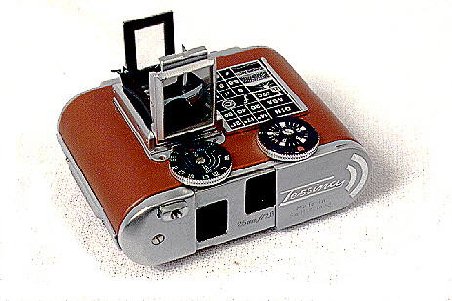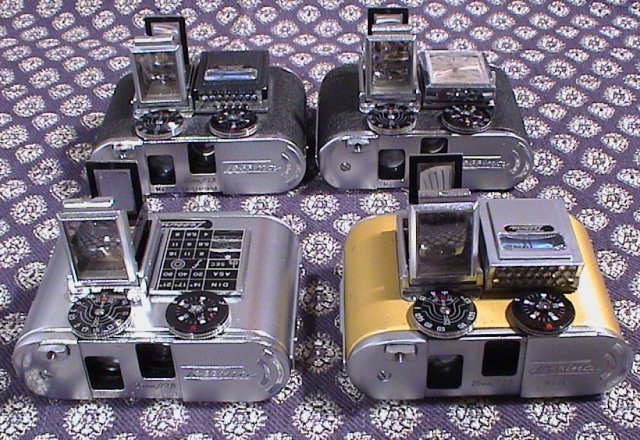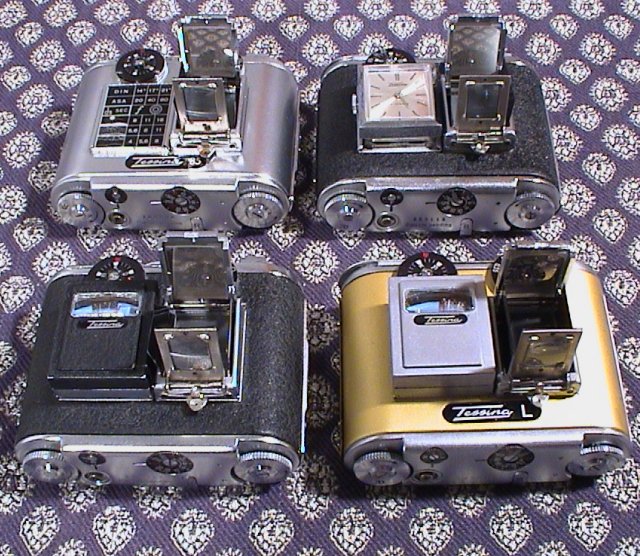
The Tessina is probably the smallest half-frame 35mm camera being a diminutive 2 1/2 x 2 x 1 inch (69 x 56 x 27mm) and weighing only 5 oz (166g). It uses 16.5" (41cm) lengths of standard 35mm film and so film options are extensive. It produces a frame size of 14x21 mm, larger than most other subminiature formats but in a camera smaller than most 16mm camera.
It is a twin-lens reflex with pop-up viewfinder and a
clock-work motor drive designed for waist-level inconspicuous photography. It has been in production since the
1960s4. It was designed and patented by Dr. Rudolph Steineck who was also the designer and patentee of the ABC wristwatch camera, several other miniature cameras, accessories and devices in the photographic and other fields.
He has German, Swiss and US patents. Some of the Tessina related patents are:
US Pat. 2,949,833 (filed Dec 1, 1954) "Twin-Lens Mirror-Reflex
Camera."
US Pat. 2,940,682 (filed Jan 25, 1956)
"Spring Mechanism for Automatically Transporting
Roll Film".
Swiss Patents:-
CH325484 Applied for March 25, 1954. "Zweiäugige Kleinbild-Spiegelreflexkamera"
1957-11-15 (Twin lens mirror reflex small-format camera).
CH340412 Applied for January 30, 1956. "Rollfilm-Aufzugvorrichtung mit Federwerk" 1959-08-15 (Winding device for roll film with spring mechanism).
CH359027 Applied for April 30,1958. "Filmspule"
1961-12-15 (Film spool).
As usual, most patents were granted several years after the application. The
drawings for the layout of the camera are rather generic, but those for the
spring motor and the spool (film cassette) are detailed.
{US & Swiss Pat information and above details supplied by John Mourikis} The initial Swiss patent of 25th March 1954 gives the application and inventor as
Steineck Dr.Rudolf ING CHEM (CH)3.
Some sources credit the design to Paul Nagel, brother of Dr. August
Nagel, the designer of the Kodak
Retina, director of Nagel Camerawerks and inventor of the 35mm film cartridge2. Two patents name Paul Nagal as co-inventor of the rewind and shutter and
film transport mechanisms. DE1037842
Rueckspulvorrichtung fuer photographische Film-Hohlspulen 1958-08-28 The patents date the design as 18th February 1955, Inventors Nagel, Paul;
Steineck Dr.Rudolf, application by Rosemarie Amado born Steineck (daughter
perhaps).
US Pat. 2,625,087 (filed May 12, 1949)
"Construction for cameras" is the US pat. for the ABC wristwatch camera.
DE1041351
Verschluss- und Transportvorrichtung fuer photographische Kameras mit
automatischem Filmtransport 1958-10-16
The other name associated with the design of the Tessina is Arthur Siegrist. The
Tessina was manufactured by W.SIEGRIST & CIE. AG.
New Tessina cameras were available from Heitz Service, subject to several month's wait until 20055. The cameras were never made in Lugano, Switzerland. That was just where the inventor lived. Concava S.A. was only the worldwide distributor and when the inventor died Concava closed their doors. The cameras have always been made in Grenchen, Switzerland by Siegrist1 and still in production in 19965. That is now their headquarters, and the manufacturer's name has replaced Concava. The film cartridge is boxed with "Concava Ltd., Lugano/Switzerland" and some include "Cut, respooled and packaged by Karl Heitz Inc. New York.
The almost 400 parts used in making the Tessina are manufactured to the same standards as for Swiss watches. Indeed, ruby jewels are used to reduce friction and wear, just as in the finest watches. The Tessina is an elegant camera, built with the precision of a fine watch.
There are three models of Tessina; the "Automatic 35 mm", "35", the 'L' . The "Automatic 35 mm" has X, F, and M synch; the "35" and the "L" have X and M synchronization all three with a standard PC flash connector. The L has a slot in the frame where the light meter slides into so that the cog on the light meter can be engaged by the aperture dial. The "Automatic 35 mm" and "35" may have been updated with this simple modification. The engraving "Made in Switzerland" is revealed when moving the lens cover on "Automatic 35 mm" and "35" models but moved to the cover itself on the "L" model.
During the production of the "Automatic 35 mm" the focal distance dial layout was redrawn.

Most are finished in bright 'chrome' stainless steel
or brushed aluminium, but a few are finished in red, gold or black. There are
two versions of the black finish. One has a soft finish and the front and back are brushed aluminium. The
other has a crackle surface including front and back. The
coloured versions fetch a healthy premium in
price.
Even rarer is the "silent" Tessina, intended for spy
work, with special nylon gears to reduce the noise of the built-in spring drive. For complete silence a noise free version without spring drive
was available.
See also models compared.
- 162g (35 automatic, #63557)
- 166g (35 automatic, brushed aluminium, #65401)
- 166g (35 automatic, black, #363012)
- 165g (? black , #363113)
- 143g (? red, #464802, 159.5g with plates and pop-up finder)
- 180g (35 brushed aluminium, #765598)
- 176g (L aluminium, #768921, 184g with bottom plate and pop-up finder)
- 154g (L gold, silent gears, #785033)
- 161.5g (L gold, #802056)
- 168g (? black crinkle, #865106)

In the Watergate, Washington DC, the capital of the United States, when the Plumbers were taken into custody a black Tessina was sized as evidence. This noise reduced version of the production Tessina used nylon gears to almost eliminate the tell-tale whirr of the automatic film advance.
Specification
- 14 x 21 exposures in special cassettes
- one lens reflects upwards to the ground glass,
- additional folding finder,
- Spring motor advance
- Tessinon 2,8/25 lens
- Shutter 1/2 - 1/500 sec.
- Versions in chrome, gold, red (above, picture from www.pacificrimcamera.com) and black
 It has a waist level finder, as well as an optional 6 power prism finder and 8 power magnifying finder. Also available are slip on meters, a wrist strap, the obligatory daylight film loader,
neck chain, pentaprism finder, noise reduction, filters, magnifier and a watch face to disguise your Tessina as the world's clumsiest looking watch.
It has a waist level finder, as well as an optional 6 power prism finder and 8 power magnifying finder. Also available are slip on meters, a wrist strap, the obligatory daylight film loader,
neck chain, pentaprism finder, noise reduction, filters, magnifier and a watch face to disguise your Tessina as the world's clumsiest looking watch.
Advantages? Wonderful precision, large negative to camera size, uses standard 35mm film stock, versatile with different accessories.
Disadvantages? With a built in miniature mechanical spring wound motor drive, most users have not found it a rugged camera - treat it gently. Another problem can be the focusing mirror out of alignment. It is also expensive, hard to find, harder to get fixed or serviced, has no tripod socket, no TTL metering or AE exposure, a fixed lens and the ground glass viewfinder shows the image reversed. Yet, it's still a great little camera.
The Tessina remains an outstanding shooter subminiature and classic collectible.
Cameras
Tessina Automatic 35 mm
Tessina 35Tessina L
Articles
The material in the following articles has been sourced from :-
- http://www.cameraquest.com/tessina.htm
- http://home.t-online.de/home/tigin/conc1.htm
- http://www.indexstock.com/content/spy/spy14.asp
- http://www.karlheitz.com/tessina.htm (closed since mid 2005)
- http://www.pacificrimcamera.com/pp/tessina.htm
- http://www.subclub.org/shop/tessina.htm
- http://nzcp.wellington.net.nz/nzcpexpo/ff98cams/ff98c05.htm
Tessina Links
- Links for Tessina cameras.
Tips
For the most detailed information on using subminiature cameras visit the link page. There have been however a number of tips posted in the usenet, list and forums that are not otherwise available.